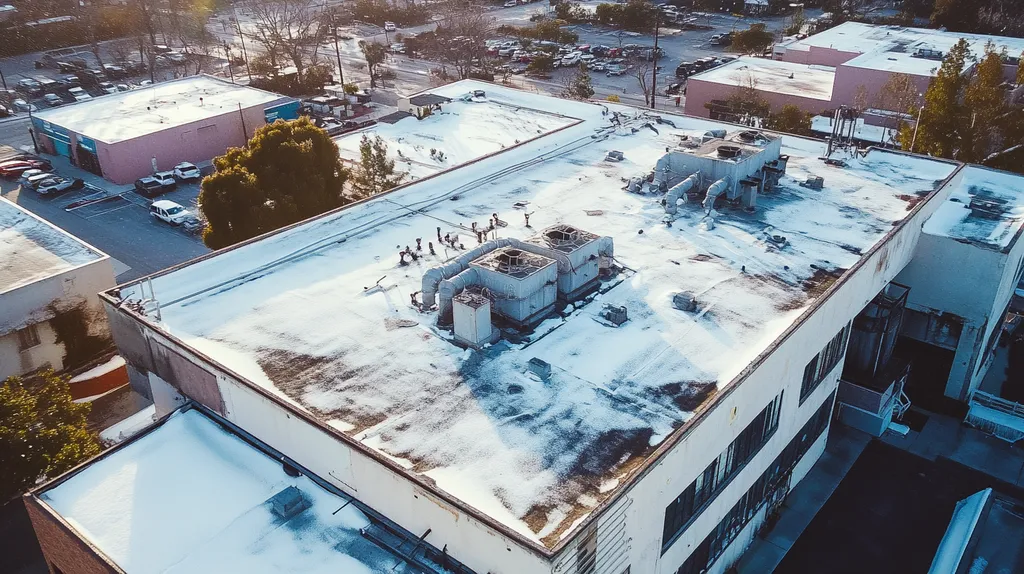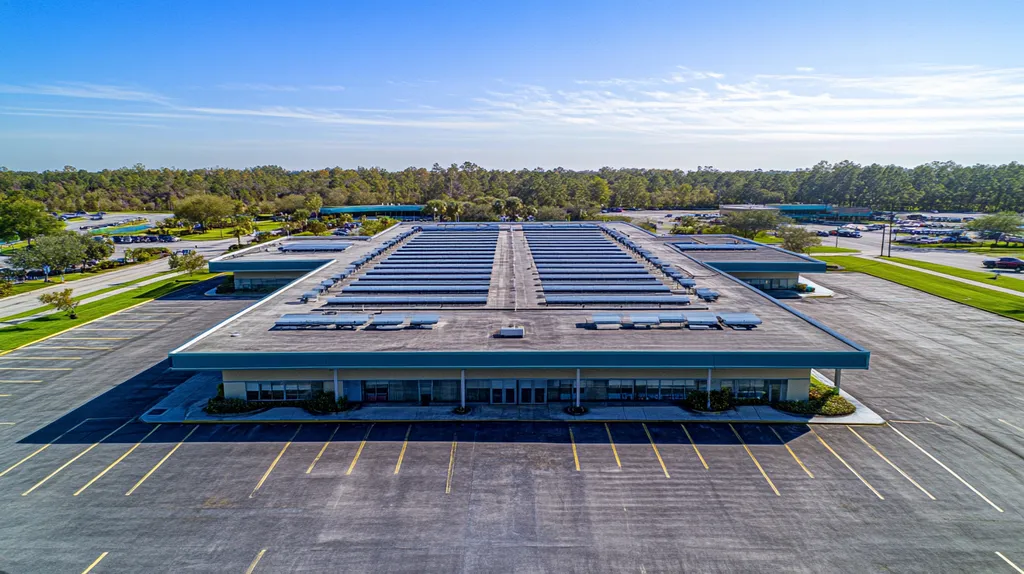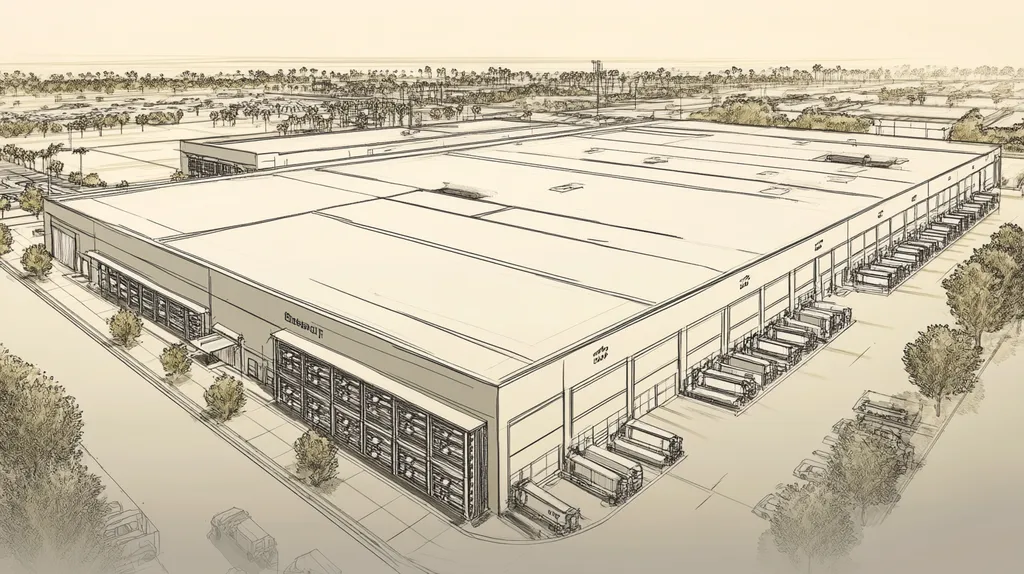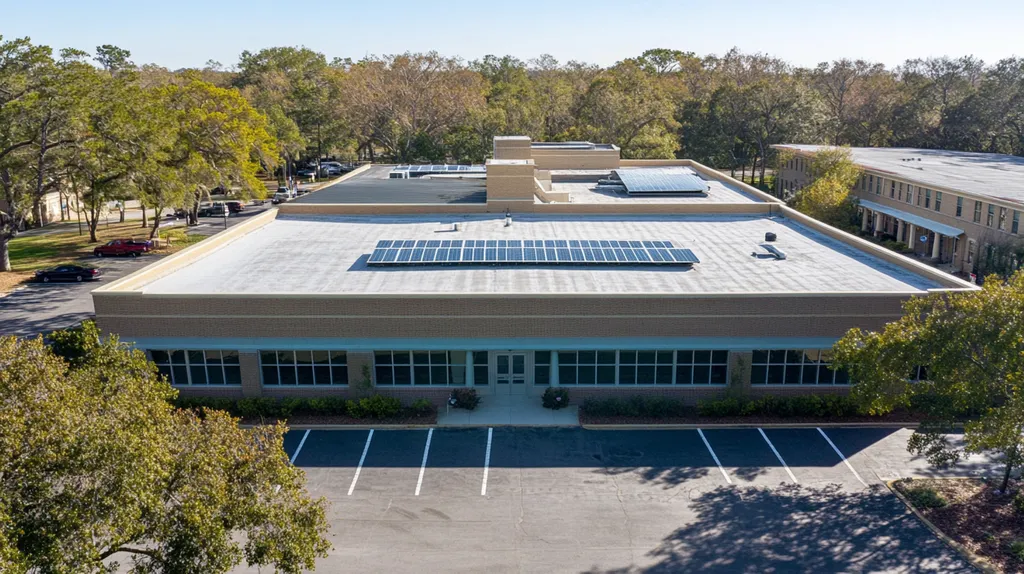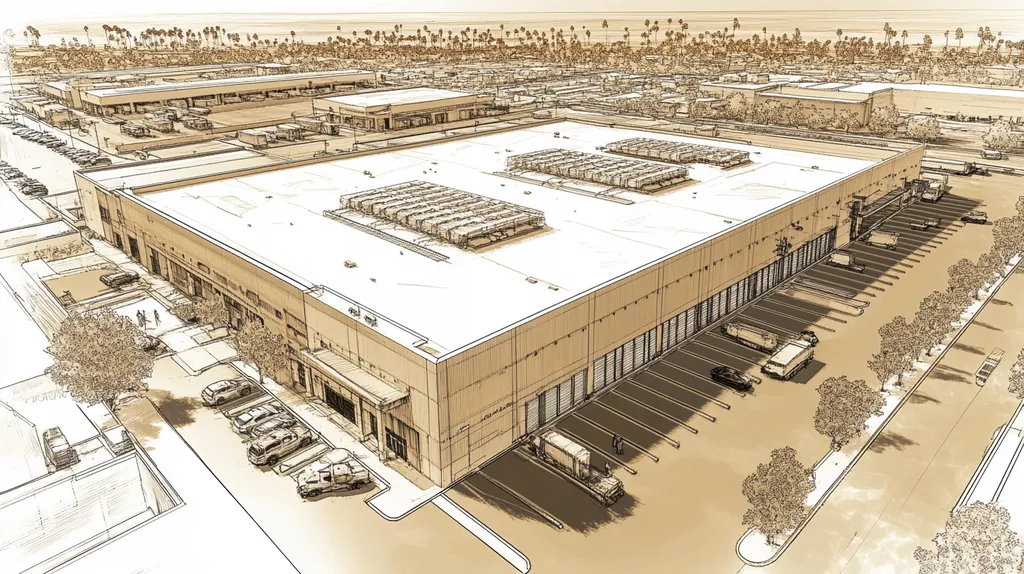In today’s industrial landscape, where a single roof failure can cost businesses millions in damages and lost productivity, understanding roofing warranties has never been more critical. Industry data shows that over 40% of commercial roof warranties are inadvertently voided due to preventable maintenance oversights.
From material coverage to installation requirements, navigating the complex world of industrial roofing warranties requires careful attention to detail and strategic planning.
This comprehensive guide examines the essential components of roofing warranties, maintenance protocols, and implementation strategies that protect your substantial investment in industrial roofing systems.
SECTION 1: FUNDAMENTAL CONCEPTS
Grasping the nuances of warranties for industrial roofing is essential for property owners and facility managers alike. Making uninformed choices can lead to significant financial setbacks, project delays, and the stress of costly roof repairs. With limited knowledge, property owners risk jeopardizing their substantial investments in roofing systems. This section will clarify the different types of warranties available, highlight the essential distinctions between manufacturer and contractor warranties, and outline common exclusions that could impact coverage.
Types of Roofing Warranties
Warranties for industrial roofing come in several forms, each designed to protect different aspects of the roofing system. The two primary categories are material warranties and workmanship warranties. Material warranties safeguard against defects in roofing materials, while workmanship warranties offer coverage for installation errors.
Typically, material warranties are issued by manufacturers and can last anywhere from 10 to 30 years, depending on the type of product. In contrast, workmanship warranties generally cover a shorter timeframe, often lasting from one to five years.
Some manufacturers might provide a combination warranty, encapsulating both material and workmanship aspects for an extended duration. Understanding these distinctions empowers property owners to make informed decisions tailored to their specific requirements.
A solid grasp of warranty types is crucial for ensuring long-term protection and financial stability against potential roof failures.
Manufacturer vs. Contractor Warranties
Comprehending the differences between manufacturer and contractor warranties is essential for making sound roofing choices. Manufacturer warranties typically cover the materials used in roofing, assuring property owners against defects or performance failures.
Conversely, contractor warranties focus on the quality of the installation, ensuring that the work adheres to industry standards. If issues arise due to improper installation, the contractor warranty becomes the primary means of addressing these problems.
Property owners should carefully evaluate both warranty types. Selecting a reputable contractor who provides a robust workmanship warranty enhances the overall reliability of the roofing system.
This layered warranty approach safeguards against both manufacturing defects and installation mistakes, serving as a vital strategy for minimizing future repair expenses.
Common Warranty Exclusions
Most roofing warranties come with specific exclusions that can impact their validity and the owner’s ability to file a claim. Common exclusions include damage from natural disasters, like storms or earthquakes, along with normal wear and tear that occurs over time. Furthermore, many warranties do not cover damage caused by inadequate maintenance or unauthorized modifications to the roof.
Property owners need to be aware of these exclusions to prevent misunderstandings and unexpected expenses. For example, a warranty may not be honored if regular maintenance isn’t conducted as required, or if unauthorized repairs occur.
Moreover, environmental factors such as pollution or seasonal weather changes can lead to degradation not covered by warranties. Understanding these limitations is vital for making proactive choices that protect investments.
By staying informed about warranty terms and conditions, property owners can maximize the benefits of their roofing warranties.
SECTION 2: SYSTEM COMPONENTS
The components of an industrial roofing system are fundamental to ensuring its longevity and effectiveness. With commercial properties incurring average roofing-related costs of $2.5 million every year, understanding warranty coverage for these components is crucial. Ignoring the specifics of materials and installation can lead to costly pitfalls, including premature roof failure. This section elucidates the key elements of roofing warranties that property owners and facility managers must prioritize.
Materials Covered Under Warranties
The materials used in industrial roofing systems form the bedrock of warranty protection. Most manufacturers provide warranties for essential components like roofing membranes, insulation, and fasteners. It is critical for property owners to verify which materials are specifically included in their warranties, as exclusions can differ considerably.
For instance, while a roof membrane may be covered for up to 30 years, the insulation might only carry a warranty of 10 years. Recognizing these differences can help property managers choose the right materials for their projects effectively. Always consult product documentation for detailed coverage and restrictions.
Moreover, certain warranties are tiered based on the quality of materials used. Choosing higher-grade materials can greatly enhance warranty terms. Therefore, investing in top-notch components is not just about quality—it’s a strategic move to maximize warranty benefits.
Ultimately, property owners should ensure that all key materials are included in the warranty. Opting for warranties that provide comprehensive coverage helps mitigate risks and enhances protection for their investments.
Installation Requirements for Warranty Validity
How roofing systems are installed plays a direct role in maintaining warranty validity. Poor installation practices can void even the strongest warranties, resulting in unnecessary costs. Manufacturers usually provide specific installation guidelines that must be followed to keep warranty coverage intact.
For example, using improper techniques or tools during installation can lead to serious flaws, such as leaks or insulation failures that worsen over time. Adhering to these guidelines solidifies the roof’s integrity and ensures that any claims remain valid.
Furthermore, the timeframe for completing the installation can affect warranty eligibility, especially for warranties that stipulate specific timelines. Property owners should communicate these requirements effectively to their contractors, ensuring they comply with all necessary conditions. Conducting regular inspections during the installation process also helps confirm adherence to these protocols.
To uphold warranty validity, it is vital for property owners to document all installation procedures. Keeping meticulous records serves as proof that guidelines were followed and can be critical in the event of a claim.
Certified Contractors and Manufacturer Specifications
Choosing a certified contractor is essential for aligning installation with manufacturer specifications and maintaining warranty coverage. Many manufacturers stipulate that only accredited professionals carry out the installation to ensure warranty validation. Working with certified contractors minimizes the risk of installation mishaps that could jeopardize coverage.
Property owners should focus on hiring contractors who meet manufacturer requirements and have a respected reputation in the industry. Requesting references and reviewing prior work is a savvy way to ensure that the chosen contractor adheres to best practices.
Additionally, some manufacturers offer training or certification programs, ensuring that contractors are well-equipped with specific installation techniques and maintenance procedures. Selecting a contractor who participates in these programs can provide reassurance regarding the quality of the installation.
In summary, understanding contractor qualifications and adherence to manufacturer specifications is crucial. This awareness can significantly influence the longevity of the roofing system and the validity of its related warranties.
SECTION 3: IMPLEMENTATION METHODS
Selecting the right warranty for an industrial roof is critical in safeguarding a substantial financial investment. Inadequate or poorly defined warranties can lead to costly repairs and legal issues. Research shows that nearly 30% of roofing failures stem from misconceptions or gaps related to warranties. This section will guide you through the strategic selection of warranties, ensuring compliance during installation, and the necessity of thorough documentation.
Selecting the Right Warranty for Your Roof
Choosing an appropriate warranty starts with understanding the various options at your disposal. Manufacturers offer a spectrum of warranties, ranging from material warranties to labor warranties, each tailored to meet specific needs and timelines. It’s vital to select warranties that align closely with the unique requirements of your project.
Additionally, warranties can differ significantly in their coverage and exclusions. For instance, some may cover only certain damage types or installations, leaving property owners exposed to common risks. Being aware of these nuances is essential to avoid gaps in coverage.
Property owners should consult experienced roofing professionals who can evaluate which warranty matches their operational needs. Discussing long-term goals and considering environmental factors might also influence the overall warranty selection process.
Lastly, meticulously reviewing the terms and conditions is crucial. A warranty that appears robust may harbor hidden exclusions that can undermine its value when you need it most.
Installation Process for Warranty Compliance
The installation process is pivotal for maintaining warranty compliance. Many manufacturers specify certain installation methods that must be strictly followed to uphold warranty validity. Neglecting these instructions can void the warranty, leading to considerable repair expenses.
Hiring certified and experienced roofing contractors is essential. They are trained to navigate warranty stipulations and ensure adherence. Contractors should be prepared to provide documentation of their certification from the manufacturer to bolster confidence in their expertise.
Conducting regular inspections during the installation phase is also advisable. This allows for early identification of potential compliance issues. Addressing these proactively can lead to significant savings in both time and costs later on.
Furthermore, clear communication among all parties involved—property owner, contractor, and manufacturer—ensures collective understanding of warranty requirements. This collaboration plays a crucial role in minimizing risks associated with warranty non-compliance.
Documentation and Record Keeping
Having robust documentation is vital for reaping the full benefits of warranty coverage. Invoices, inspection reports, and installation photos are critical pieces of evidence for any future claims. Property owners should maintain detailed records to support warranty claims effectively.
Utilizing digital tools can enhance the documentation process. Cloud-based systems offer easy storage and access to warranty-related documents, improving efficiency and organization.
In addition, maintaining a maintenance log that details all repairs and assessments can strengthen warranty claims. This log demonstrates the property owner’s commitment to proactive maintenance, which is beneficial during claim evaluations.
Finally, scheduling regular reviews of warranty documentation is key. Periodically auditing the collected paperwork can help uncover any gaps or missing documents that might jeopardize potential warranty claims down the line.
SECTION 4: MAINTENANCE REQUIREMENTS
Effective maintenance is not merely recommended; it is vital for safeguarding your investment in industrial roofing. Research indicates that around 80% of roofing failures can be traced back to insufficient upkeep. To prevent costly repairs and extended operational downtime, property owners and facility managers must establish a proactive maintenance plan. This section will delve into the significance of biannual inspections, outline routine maintenance tasks necessary for warranty compliance, and explain how addressing minor issues can thwart major repairs.
Biannual Inspections and Their Importance
Biannual inspections are essential to prolonging the life of industrial roofs. These checks allow property managers to spot potential problems before they develop into serious issues. It’s advisable to schedule inspections during the spring and fall, ensuring roofs are ready to face the upcoming seasonal challenges.
During these inspections, qualified roofing professionals will examine crucial components like seams, flashings, and drainage systems. Identifying small leaks or early signs of wear during these evaluations can save property owners thousands in future repair costs. Moreover, these proactive inspections help maintain warranty eligibility by keeping a documented history of the roof’s condition over time.
Each inspection should culminate in a detailed written report that outlines findings and recommendations. Such documentation is invaluable for meeting warranty requirements and demonstrating responsible maintenance practices. By developing solid inspection habits, property owners can significantly enhance the longevity and performance of their roofs.
Routine Maintenance Tasks for Warranty Compliance
Routine maintenance tasks are integral to fulfilling warranty maintenance requirements. These essential activities typically include cleaning gutters, removing accumulated debris, and checking for signs of wear and tear. A clearly established maintenance schedule can help facility managers keep track of these critical tasks.
Neglecting to clear debris can lead to drainage problems, which may result in water pooling and subsequent leaks. Property owners should routinely inspect the roof for any buildup of leaves, dirt, or other obstructions. Regular cleaning is not just a chore; it’s a necessary step to uphold warranty protections and function effectively.
In addition, all repairs and maintenance should be carried out using materials that meet or exceed manufacturer specifications. Failing to do so could jeopardize warranty claims, underscoring the importance of adhering to prescribed guidelines throughout the maintenance process. By prioritizing compliance, property owners protect both their roofs and their investments.
Addressing Minor Issues Before Major Repairs
Promptly addressing minor roofing issues can prevent them from escalating into costly major repairs. Property managers should cultivate a habit of responding quickly to small concerns like cracks or minor leaks. Left untreated, these small problems can grow into extensive damage and more expensive repairs.
For instance, a small leak can lead to mold growth and significant structural damage if not addressed immediately. Quick repairs not only safeguard the roof but also enhance the overall performance of the building. Taking a proactive approach helps avoid disruptions in business operations and promotes a safer work environment for employees.
Keeping a detailed log of all minor repairs and maintenance tasks will support warranty claims in the future. This documentation serves as evidence of due diligence in upkeep, which can be critical if issues arise down the line. By adopting a preventive mindset, facility managers can ensure their roofing investments remain solid and compliant with warranty stipulations.
SECTION 5: PERFORMANCE METRICS
Performance metrics serve as the backbone for property owners and facility managers when navigating the complexities of industrial roofing warranties. With nearly 30% of roofing failures linked to inadequate coverage and subpar material quality, understanding these metrics is essential. By evaluating warranty performance, stakeholders can gain clarity on the reliability of their roofing systems. This section dives into three vital areas: evaluating warranty coverage, assessing workmanship and material quality, and tracking claims effectively.
Evaluating Warranty Coverage and Limits
To ensure a successful roofing investment, understanding warranty coverage and limits is crucial. Warranties vary widely, typically ranging from 10 to 30 years, with clear distinctions between material and workmanship coverage. A thorough evaluation helps property owners identify what’s included—such as protection against weather damage, UV exposure, and punctures.
It’s just as important to examine the exclusions within each warranty. Many plans won’t cover damage resulting from poor maintenance or extreme weather conditions. Being aware of these limitations can prevent unwelcome surprises that may result in expensive repairs.
Stakeholders should also consider the transferability of the warranty. A transferable warranty not only adds value to the property but also safeguards future owners, enhancing the overall appeal of the investment.
Lastly, comparing warranties from different manufacturers using performance metrics enables informed decision-making, which leads to more durable and reliable roofing solutions.
Assessing Workmanship and Material Quality
Quality assurance in workmanship is a critical factor influencing the longevity of any roofing system. While material quality significantly impacts roof performance, even the best materials can fail if installed improperly. Thus, assessing both material and installation quality is paramount for property managers.
Choosing certified and experienced roofing contractors enhances the likelihood of quality workmanship. Contractors may vary in expertise, so checking qualifications and past project references is vital. A well-installed roof is better equipped to withstand environmental challenges and fulfills warranty obligations effectively.
Conducting regular inspections and routine maintenance is also essential to uphold warranty requirements. When issues arise, demonstrating a track record of regular upkeep can greatly assist in claim approvals, providing further assurance in warranty matters.
In summary, a strong focus on both material and workmanship quality can lead to optimal roofing performance, contributing to the effectiveness of the warranties in place.
Tracking Warranty Claims and Resolutions
Effectively tracking warranty claims and their resolutions can significantly improve the overall roofing experience for facility managers. An organized claims process is crucial for addressing issues promptly, thereby minimizing operational downtime.
Meticulous documentation is fundamental when it comes to warranty claims. Keeping accurate records of inspections, maintenance, and repairs establishes a clear history for the warranty provider, ensuring that claims are well-supported and increasing the likelihood of favorable outcomes.
Knowing the typical timelines for claim resolutions is equally important. Stakeholders should familiarize themselves with response times from their warranty providers and follow up as needed. Proactively managing these relationships can expedite the claims process.
Lastly, analyzing the results of past claims helps anticipate future issues. By identifying patterns in claims and resolutions, property managers can make informed decisions about roofing maintenance and potential replacements down the road.
SECTION 5: PERFORMANCE METRICS
Performance metrics are essential for property owners and facility managers navigating the complexities of industrial roofing warranties. In fact, nearly 30% of roofing failures can be linked to inadequate coverage and the use of substandard materials. Understanding these metrics allows stakeholders to confidently assess the dependability of their roofing systems. This section will explore key performance areas, including warranty coverage, the quality of workmanship, and effective tracking of claims.
Evaluating Warranty Coverage and Limits
The first step in making a solid roofing investment is to grasp warranty coverage and limits. Warranties can vary significantly, often lasting from 10 to 30 years, and they delineate distinct categories for material and workmanship coverage. A thorough evaluation empowers property owners to understand what protection is included, like resistance to weather damage, UV exposure, and punctures.
It’s equally important to scrutinize warranty exclusions. Many plans do not cover damage resulting from neglect or extreme weather events. Knowing these limitations helps prevent unwelcome surprises and unexpected costs later on.
Stakeholders should also consider whether the warranty is transferable. A warranty that can be passed on to future owners adds value to the property and enhances its appeal.
Finally, comparing warranties among various manufacturers using performance metrics allows for informed decision-making, leading to more resilient roofing solutions.
Assessing Workmanship and Material Quality
The quality of workmanship plays a crucial role in the longevity of any roofing system. While the quality of materials is undeniably important, even the best products can fail if they are installed improperly. Therefore, property managers must assess both material quality and installation practices.
Hiring certified and experienced roofing contractors can significantly enhance workmanship quality. Not every contractor has the same level of expertise, so checking qualifications and past project references is essential. A well-installed roof will be better equipped to handle environmental elements and meet warranty obligations.
Regular inspections and maintenance are also vital for complying with warranty requirements. If issues arise, showing a history of regular upkeep can facilitate claim approvals and offer additional protection in warranty situations.
In summary, placing a strong emphasis on both material quality and workmanship can lead to optimal roofing performance, greatly contributing to the effectiveness of warranty coverage.
Tracking Warranty Claims and Resolutions
Effectively managing warranty claims and their resolutions can greatly improve the overall roofing experience for facility managers. An organized claims process is vital for addressing issues quickly, which minimizes operational downtime.
Thorough documentation is essential when submitting warranty claims. Keeping accurate records of inspections, maintenance, and repairs establishes a clear history for the warranty provider, ensuring that claims are backed up with evidence and increasing the chances of a positive resolution.
Understanding the typical timelines for claim resolutions is also crucial. Stakeholders should be aware of the usual response times from their warranty providers and should follow up as needed. Taking a proactive approach in managing these relationships can help speed up the claims process.
Finally, examining the results of previous claims helps prepare for future issues. By identifying patterns in claims and their resolutions, property managers can make informed decisions regarding roofing maintenance and potential replacements moving forward.
The Bottom Line
With industrial roofing failures costing businesses an average of $3.5 million annually in damages and lost productivity, understanding and properly managing warranties has never been more critical.
Property owners must recognize that warranties serve as more than just documentation – they represent a comprehensive system of protection that requires active management and compliance.
From selecting certified contractors and maintaining detailed records to implementing rigorous maintenance protocols, each element plays a vital role in preserving warranty validity.
By following the strategies outlined in this guide, facility managers can maximize their warranty protection while significantly extending their roofing system’s lifespan and performance.
The future of industrial roofing depends on proactive warranty management, making it essential for stakeholders to implement these practices immediately.
FREQUENTLY ASKED QUESTIONS
Q. What types of warranties are available for industrial roofs?
A. Industrial roofs typically come with material and workmanship warranties. Material warranties cover defects in roofing materials, lasting from 10 to 30 years, while workmanship warranties address installation errors, usually lasting 1 to 5 years. It’s important to understand these distinctions for informed decision-making.
Q. How do I ensure my commercial roof warranty remains valid?
A. To keep your warranty valid, you must adhere to specific installation guidelines and conduct regular maintenance checks. Hiring certified contractors who follow the manufacturer’s instructions is crucial, and maintaining a detailed record of all inspections and repairs can support any future warranty claims.
Q. What common exclusions should I watch for in industrial roofing warranties?
A. Common exclusions in industrial roofing warranties include damage from natural disasters, normal wear and tear, and issues arising from improper maintenance or unauthorized repairs. Being aware of these exclusions helps property owners avoid misunderstandings and unexpected expenses.
Q. Why are biannual inspections important for my commercial roof?
A. Biannual inspections are crucial for spotting potential issues before they escalate into costly repairs. Scheduling these checks during spring and fall helps ensure your roof is prepared for seasonal challenges, maintaining warranty eligibility and prolonging the life of your industrial roof.
Q. How can I assess the quality of the workmanship on my roof?
A. Assessing workmanship quality involves checking the contractor’s qualifications and past project references. Hiring certified professionals increases the likelihood of effective installation, ensuring that your roof can withstand environmental challenges and support compliance with warranty requirements.
Q. What should I include when documenting maintenance for warranty claims?
A. Key documentation for warranty claims should include inspection reports, maintenance logs, invoices, and installation photos. Detailed records support your claims and demonstrate proactive management of your roof, which can significantly improve your chances of a successful claim.
Q. How often should I review my roofing warranty documentation?
A. Regular reviews of roofing warranty documentation are essential, ideally annually. This practice helps identify any gaps or missing documents that could jeopardize warranty claims. Keeping everything organized ensures you are well-prepared in case any issues arise.

